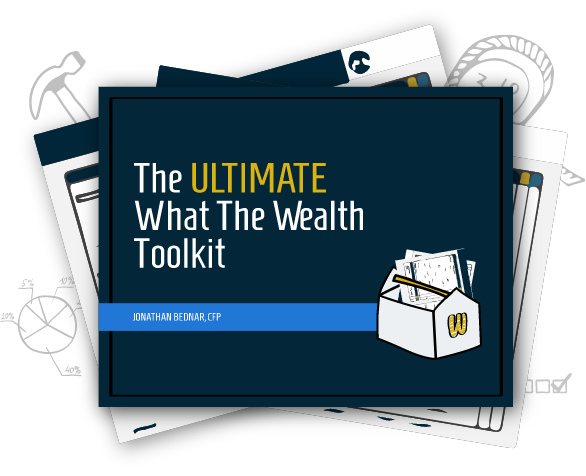Ep #45: The Act Of Keeping It Simple
I was recently in a meeting with a client and their CPA. The client had worked with the CPA for many years, and some time ago, I took over as their financial advisor. The client’s financial planning strategy had been put in place by the CPA and previous advisor.
In the meeting, the client was venting some frustration over the complexity of the strategy; they didn’t understand it and didn’t understand how it was helping them reach their financial goals. It was too complex for them, me, and even for the CPA who, try as they might, couldn’t explain it either, at least not in a simple manner.
A Picture is Worth a Thousand Words
Carl Richards is a CFP and known as the “Sketch Guy.” Richards creates simple doodles for the New York Times that break complex personal finance concepts. I grew up seeing my father, a financial advisor, draw topics out on yellow legal pads for his clients, a tradition I’ve continued. I post some of my doodles on my LinkedIn and other social media pages.
One of my favorite doodles by Carl is “Complexity Elegant Simplicity.” The doodle can apply to any profession. From a financial planning perspective, the first line is the idea—the dream—a comfortable retirement traveling and spending time with the family, for example. The bit in the middle, the complex part, is my job, understanding and executing the complexities of creating that retirement plan. The line on the right is making this retirement plan elegantly simple, so the plan is easy to understand.
Insert doodle image here
Doctors are another example. When I go to the doctor, I want them to tell me what I need to do to reach my goal of living a healthy, long life. And then live a long, healthy life! Those are the two straight lines. The middle part, the doctor’s part, is my cholesterol numbers good or bad? What about my blood pressure? What do the top and bottom values even mean? What are triglycerides?
I don’t know what those terms and their corresponding numbers mean, and honestly, I have no interest in finding out! When I hear medical jargon, my eyes glaze over. I want the doctor to tell me, “To improve these numbers and live a long and healthy life, you need to eat less junk food and do more exercise.” Roger that, doc. Over and out!
When I start talking in industry’s jargon, my client’s eyes glaze over. When I draw doodles for my clients rather than using words to explain the chaotic bit in the middle, they understand much better and much faster than had I spent two hours explaining things with words and numbers.
Even showing hard numbers on a calculator can be lost on people. Numbers are hard to comprehend because we don’t have a lot of real-world experience with them in a way. Many of us have ever held or seen $30,000 cash or $300,000 or $3,000,000. We know what $100 is because we’ve seen it, we might even have one in our wallet, but numbers magnitudes larger are just hard to fathom.
Pros Can Be the Problem
There is money, lots of it, in making a subject seem incomprehensible to the average person—especially a subject as critical to all of us as money is. You don’t want to screw up your finances because it would mean screwing up your life.
So many financial professionals try to make things like investing seem so complex, only they can do it. Well, maybe they could explain it to you a bit. No, no! That’s not possible. Just leave it to the pros. And a lot of us can use financial jargon that we assume clients understand, but it can be Greek to many people. If you don’t know the meanings of words used to explain something to you, it won’t be possible to understand the strategy.
These kinds of professionals think the more complex they make something, the more value they are providing. They are providing something no one else can! [Tounge-in-cheek]
It’s Simple, But It’s Not Easy
This is not to say that creating a solid financial plan is easy. It isn’t. There are so many factors that go into every plan because each client is different; they have different circumstances, dreams, values, and risk tolerance levels. And there are a lot of variables we have to build into a plan that we don’t control, like the local, national, and international economies, local, national, and international politics, taxes, the market, interest rates, and as we’ve all recently learned, global pandemics.
But still, you have to understand not all of the above but how the plan we create helps you. If you don’t, you’re less likely to stick with it. Saving money for the future is not much fun compared to spending money on whatever we want whenever we want it. Eating a salad instead of a burger isn’t very fun. That’s why the professionals have to explain to the client, in a simple, elegant way, why the less fun option provides the greater, long-term benefit.
Explain Like I’m Five
Reddit has a great subReddit called Explain Like I’m Five (ELI5). People can ask to have complex things explained. A few recent examples:
● If Jupiter is a planet made of glass, how does it keep its shape?
● How do allergies work, and how can people develop allergies later in life?
● Why is sulfuric acid used in the production of nitrocellulose?
It’s a fun, educational way to kill time and reminds me a lot of what I’m doing when I draw doodles for my clients.
Doodling
If your financial advisor (or anyone else!) is explaining something you don’t understand, speak up! Ask them to explain it to you on the back of a napkin. If they won’t or can’t, you need to find someone else who can.
When we think something is beyond our comprehension, it can frighten us into inaction. Inaction, in some cases, is much more dangerous than making mistakes, not investing, for example. If your money is sitting around in a savings account making 0.01% interest because you’re afraid of the stock market, that is much more dangerous than making and learning from some bad investments.
In my first meeting with clients, we create the One Page Wealth Plan. It identifies the client’s core values and dreams, tracks some numbers that gauge their financial health, explains the 5 big risks of retirement, and looks at what we can do in the next 90 days to move forward. That’s it! One page. Simply elegant.
I was recently in a meeting with one of my clients and their CPA when they declared that they no longer wanted to use the strategy they had been using for over ten years. After some discussion, it became clear that what they were really saying was “we don’t see the value in this strategy.”
In other words, the issue was not with the strategy—the issue was with the client’s understanding of the strategy. So, in this episode, I’m diving into why keeping things simple can actually add value to your clients. Listen in as I share some methods that you can use to keep things simple and why the role of any good advisor is to explain the complex stuff in a way that non-advisors can understand.
Listen to the Full Episode:
What You’ll Learn In Today’s Episode:
- Why simplicity does not negate value.
- The importance of explaining the need for something in a simple way.
- Methods for explaining things in a simple way.
- Why it’s an advisor’s role to keep things simple.
Ideas Worth Sharing:
“Sometimes, as professionals, we make things more difficult.” – Jonathan Bednar
“We know what $100 is because we hold it frequently. And so, anything above and beyond that becomes complex, and it’s our job to make it simple.’” – Jonathan Bednar
“We need to be simple. That doesn’t mean the strategy has to be easy, but it does have to be simple.” – Jonathan Bednar
Resources In Today’s Episode:
- Jonathan Bednar: Email | Twitter | LinkedIn
- Carl Richards
- What The Wealth?! by Jonathan Bednar
If you’d like to learn more about our process and work with me, you’ll find the information on our website under Start Here. We’ll work together to Create the Life You Love.




